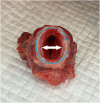Pre-hospital emergency cricothyrotomy in dogs part 2: Airway sealing and ventilation using cricothyrotomy tubes
- PMID: 36876002
- PMCID: PMC9981793
- DOI: 10.3389/fvets.2023.1129462
Pre-hospital emergency cricothyrotomy in dogs part 2: Airway sealing and ventilation using cricothyrotomy tubes
Abstract
Cricothyrotomy (CTT) has been recommended for use in the pre-hospital setting for military working dogs and Operational K9s during airway emergencies. Although the CTT can establish a patent airway for spontaneous ventilation, the ability to seal the airway and provide positive pressure ventilation (PPV) using tubes designed for humans has not been determined. Using various CTT tubes placed in cadaver dog airways, this study aimed to determine: (1) Whether the tube cuff could create a functional airway seal with safe intra-cuff pressures; (2) The magnitude of delivered tidal volume (TV) loss during a standard breath to assess the possibility of delivering an adequate tidal volume with a bag-valve device (BVM); (3) The best performing tubes for either test; (4) The reasons behind the findings using observations from upper airway endoscopy, dissection, and measurements. Cadaver dogs of similar weights to MWD and Operational K9 breeds had various CTT tubes placed including three from commercial kits, a standard endotracheal tube, and a tracheostomy tube. The minimum occlusive volume technique was used to inflate the tube cuff and a pressure ≤ 48 cm H2O with an adequate seal was considered successful. Individual TVs were calculated for each dog and added to the volume lost during delivery of a standard breath from an ICU ventilator. Endoscopy and airway dissection were performed to assess the relationship between tubes cuffs and the airway. The tubes from the CTT kits performed poorly with regards to producing an airway seal with the H&H tube failing to seal the airway all tests. Tracheal dimensions were significantly associated with successful airway sealing (P = 0.0004). Tidal volume loss could be compensated using a BVM in 34/35 tests with the H&H tube in cadaver 8 the only to fail. Tracheal airway sealing is influenced by airway anatomy when tube cuffs are inflated to a target pressure and larger tubes do not always provide a better seal. The CTT tubes tested have the potential to facilitate ventilation with a BVM under the conditions set in this study. The 8.0 mm endotracheal tube performed the best and the H&H the worst in both tests.
Keywords: CICO; H&H; Portex; airway—obstruction; cricothyrotomy; military working dog; operational K9; tracheostomy.
Copyright © 2023 Hardjo, Haworth, Croton, Purcell and Goodwin.
Conflict of interest statement
The authors declare that the research was conducted in the absence of any commercial or financial relationships that could be construed as a potential conflict of interest.
Figures








Similar articles
-
Prehospital Emergency Cricothyrotomy in Dogs Part 1: Experiences With Commercial Cricothyrotomy Kits.Front Vet Sci. 2021 Sep 16;8:705695. doi: 10.3389/fvets.2021.705695. eCollection 2021. Front Vet Sci. 2021. PMID: 34604369 Free PMC article.
-
Concepts of Prehospital Advanced Airway Management in the Operational K9: A Focus on Cricothyrotomy.J Spec Oper Med. 2019 Spring;19(1):99-106. doi: 10.55460/KV13-RV6C. J Spec Oper Med. 2019. PMID: 30859536
-
Effect of Lanz pressure regulating valve on self-sealing mechanism and air leakage across the tracheal tube cuffs in a benchtop model.J Intensive Care Med. 2013 Jul-Aug;28(4):247-51. doi: 10.1177/0885066612452847. Epub 2012 Jul 24. J Intensive Care Med. 2013. PMID: 22833049
-
Tracheostomy tubes and related appliances.Respir Care. 2005 Apr;50(4):497-510. Respir Care. 2005. PMID: 15807912 Review.
-
Tracheostomy tubes.Respir Care. 2014 Jun;59(6):956-71; discussion 971-3. doi: 10.4187/respcare.02920. Respir Care. 2014. PMID: 24891201 Review.
Cited by
-
Pilot cadaveric study on the feasibility of cricothyroidotomy and the associated complications in 30 cats.Front Vet Sci. 2024 Apr 8;11:1365780. doi: 10.3389/fvets.2024.1365780. eCollection 2024. Front Vet Sci. 2024. PMID: 38650852 Free PMC article.
References
LinkOut - more resources
Full Text Sources

